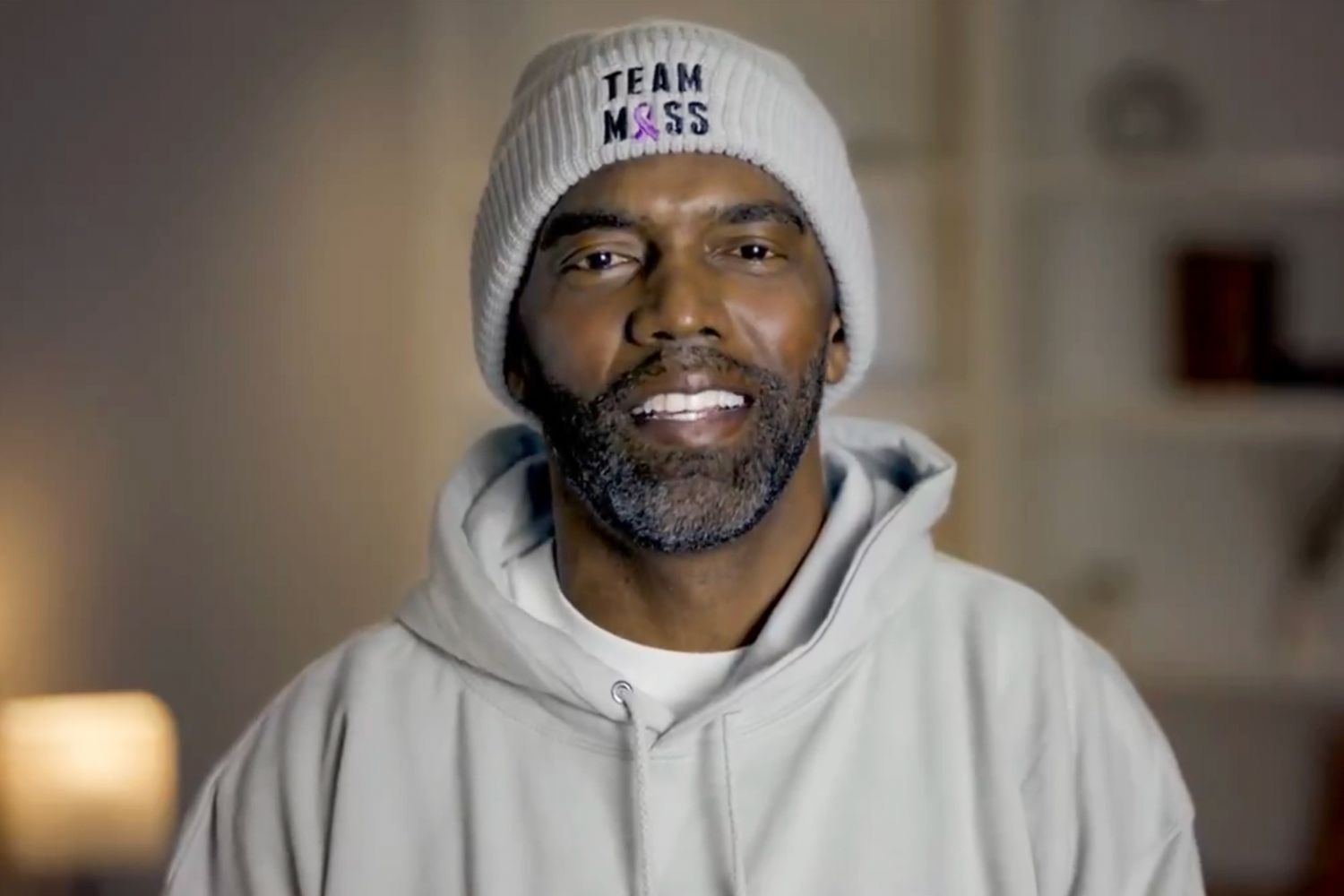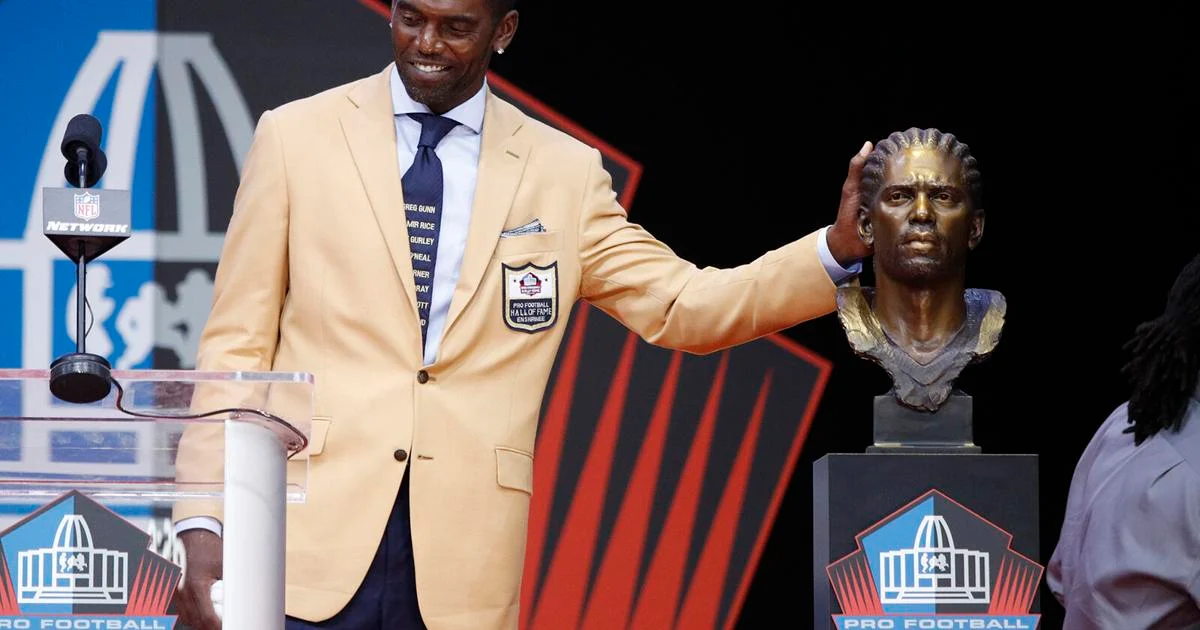Randy Moss:
Randy Moss burst onto the NFL scene in 1998 when he was drafted by the Minnesota Vikings. With his rare combination of speed, height, and catching ability, he quickly became a household name. Over a 14-season career, Moss played for teams including the Vikings, Patriots, Raiders, Titans, and 49ers. He amassed 15,292 receiving yards and 156 touchdowns—the second most in NFL history at the time.
Wikipedia
He earned multiple Pro Bowl and All-Pro honors, and was inducted into the Pro Football Hall of Fame in 2018. But behind the highlight reels lay a story of physical stress, injuries, and the ever-present burden athletes carry on their bodies.
During his career, Moss battled hamstring injuries, toe injuries, and others that challenged his durability. Early in his Patriots tenure, for example, he missed time due to a hamstring issue during training camp.
Wikipedia
Yet those battles shaped him—not just as a player, but as a man who would later confront health far beyond the gridiron.

Health Challenges and Injuries During His NFL Years
For any top athlete, the body is both instrument and risk. Over 14 seasons, Moss’s body took immense strain. Though much of the public focus is on spectacular plays, less discussed are the small tears, nagging pains, and preventive routines behind the scenes.
Health Challenges and Injuries During His NFL Years
Sprint routes, sudden cuts, and high velocity place tremendous stress on hamstrings, calves, and joints. Moss’s explosive style meant he was especially prone to muscle strain. He faced multiple injuries that required rest, physical therapy, or modified workloads.
The Hidden Toll: Wear and Tear
Decades of high impact—jumping, collisions, sudden acceleration—take a cumulative toll on joints, cartilage, and tendons. Many NFL veterans speak of chronic knee, shoulder, or spinal discomfort after retirement. Moss was not immune to that reality, even if he rarely spoke publicly about it.
Discipline and Recovery
Moss’s approach to injury recovery mattered. He often prioritized rest, rehab, and strength training to maintain functional mobility. Elite athletes typically rely on modalities like cold therapy, soft tissue work, neuromuscular training, and personalized conditioning. Although specific details of Moss’s rehab routine are less well documented, it’s clear he understood the value of upkeep to prolong his elite performance.
Those years gave him lessons that would later inform his approach to health in retirement—and beyond.
Post-Retirement Lifestyle and Fitness Routine
Retirement for an athlete often brings an abrupt shift: the body is suddenly without its daily high intensity demands, yet the habits and expectations remain. For many, that transition is difficult. For Moss, it became a new chapter of health experiments.
Transition from Athlete to Ordinary Body
In retirement, Moss faced the challenge of adjusting caloric intake, workload, and movement patterns. What worked on the field no longer applied. Many retired players struggle with weight gain, loss of muscle, or metabolic changes. Moss’s journey reflects both the successes and struggles inherent in that transition.
Maintaining Movement
While public details of his daily workouts are limited, Moss has been seen maintaining an active life: walking, light resistance training, yoga, or mobility work. These practices help preserve joint health, flexibility, and metabolic balance. Especially for former athletes, consistent movement is more valuable than intense sessions.
Balancing Rest and Activity
One key lesson: rest is not optional. After the rigorous years in the NFL, the body needs deliberate recovery phases. Moss learned that rest days, sleep, and careful listening to signals (fatigue, soreness) are essential to prevent regression.
Diet, Training, and Wellness Habits
The elite diets and training routines of professional athletes are often shrouded in mystery—and myth. But Moss’s recent health revelations have shone light on how much diet and wellness still matter, even decades after peak performance.
Nutritional Awareness
Although we don’t have full public records of Moss’s diet today, his own statements suggest he valued clean, whole foods and was surprised when health issues emerged despite doing “everything right.”

In his 2025 interview on Good Morning America, Moss said:
“I just think that when you live your life … a certain type of way of, you know, eating right, taking care of your health … and all of a sudden you get diagnosed with cancer … I was overwhelmed.”
Training and Conditioning
Even post-retirement, light resistance work, flexibility, and core stabilization remain essential. Moss’s posture, stability, and functional strength likely played roles in preserving mobility and mitigating chronic pain.
Wellness Practices
Beyond diet and workouts, wellness includes sleep hygiene, stress management, and routine checkups. Moss’s health journey—revealing his cancer diagnosis—offers a stark reminder that regular medical surveillance is vital, even for high performers. He urged fans to “get your checkups, get your blood work done” in public statements after his diagnosis.
Randy Moss’s Mental and Emotional Health Journey
Health is never purely physical. For Moss, the emotional weight of illness, loss, and legacy has played a profound role in his journey through “Randy Moss Health.”
Confronting Mortality
When diagnosed with bile duct cancer (cholangiocarcinoma) in late 2024, Moss described the shock of realizing that even his disciplined lifestyle offered no immunity. He told Good Morning America that the diagnosis “hit like a ton of bricks.”
The emotional shock forced him into introspection: about family, faith, his responsibilities, and his legacy.
Support, Vulnerability, and Asking for Help
Moss did not face this alone. His wife Lydia served as a caretaker and emotional anchor during the darkest times. He resisted support at first, saying he was used to doing things on his own, but later acknowledged the importance of letting family in.
The emotional layer of health recovery often matters more than we expect. Pride can block healing; vulnerability, when met with love, can be transformative.
Legacy, Identity, and Purpose
For much of his life, Moss’s identity was tied to his athletic excellence and public presence. A health crisis can unsettle identity. But Moss leaned into his role as motivator and mentor—supporting fellow athletes like Deion Sanders, who also faced his own cancer battle. Moss’s willingness to share his story became part of his legacy.
Lessons from Randy Moss’s Approach to Health
The life of Randy Moss offers more than entertainment value; it holds lessons we can all use. Here are 7 resilient lessons from his health journey:

Lesson Insight
- Health is not guaranteed Even the top athletes can be struck by serious illness—humility matters.
- Preventive care matters Early detection via routine exams can change outcomes.
- Rest and recovery are tools, not luxuries Overtraining or ignoring fatigue invites disaster.
- Emotional strength is essential Mindset, acceptance, and vulnerability enhance physical recovery.
- You don’t heal alone Support systems, community, and love matter in navigating health crises.
- Legacy includes health transparency Sharing struggles inspires others to take health seriously.
- Resilience is built, not given Recovery is a long game of consistency, hope, and incremental progress.
These lessons reflect not just “Randy Moss Health,” but the universal dance between ambition, vulnerability, and survival.
How Fans Can Apply Randy Moss Health Principles in Daily Life.
You may not be an NFL athlete, but Moss’s principles are remarkably adaptable to everyday life. Here’s how:
Schedule annual checkups and screenings
Even if you feel fine, underlying conditions can hide until late stages.
Prioritize movement over intensity
Daily walking, stretching, or light strength work beats sporadic extremes.
Embrace recovery
Use good sleep habits, rest days, mobility work, and stress reduction techniques.
Build emotional resilience
Journaling, therapy, or conversations can help you process surprise health news.
Allow help in
Share openly with trusted friends or family when challenges emerge.
Stay disciplined with fundamentals
Consistency in diet, hydration, sleep, and moderation often outperforms extremes.
Lead by example
If you overcome a health setback, your story might inspire someone else to act.
By applying these steps, you honor your own health—and the spirit of “Randy Moss Health.”
The Role of Discipline, Motivation, and Legacy in Long-Term Wellness
When we talk about health beyond crisis, three threads consistently weave through success stories: discipline, motivation, and legacy.
Discipline as Daily Commitment
Moss’s career was built on daily reps—training, diet, film study. Likewise, health is built by daily small choices: sleep, movement, and avoiding extremes. Discipline is what carries you on days you don’t feel motivated.
Motivation Through Purpose
Moss’s identity, competitive fire, and desire to inspire others have become renewed motivators during his recovery journey. In health, connecting actions to purpose (family, longevity, service) often sustains resolve better than abstract goals.
Legacy Beyond Performance
His recent transparency turns health into part of his legacy. For you, that could mean modeling healthy behavior, opening conversations about vulnerability, or leading a community initiative. A life well lived is measured not just in years, but in contributions to others.
Together, these forces—discipline, motivation, and legacy—help anchor long-term wellness far beyond physical strength.
Learn more More blog